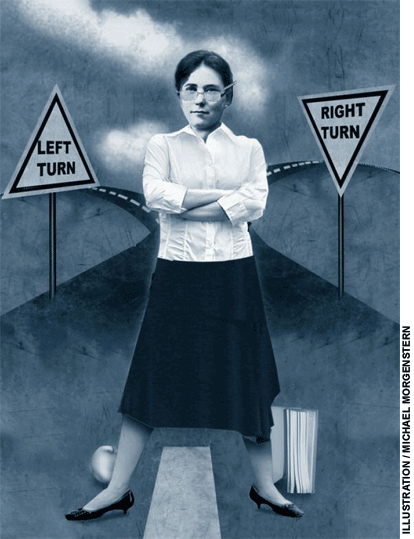
In our liberal-democratic society there is always a desire to separate the teaching of values from the teaching of reading, writing, and mathematics, the so-called value neutral subjects. But we have learned–and every parent who has done home work with his child knows–that, like it or not, we teach values in the course of teaching these subjects. We teach, for example, the values of hard work, of doing things that we might not like, of persevering in the face of difficulty, of listening to and respecting the efforts of adults, of self-initiated effort, of postponement of gratification, and of meeting deadlines. All of these simple lessons are moral instruction, lessons about what is important and about what ought to be taken seriously. So even if what we teach is value neutral,our teaching–by the manner in which we do it and the nature of our interactions in the course of it–conveys messages to our children about how they should regard themselves, consider others, and meet their obligations. Teaching is as much amoral effort as it is an intellectual enterprise; teachers not only educate our children how to think and solve problems, they also inform children’s beliefs about what is right, good, and important in life, shaping their values in the process.
There are nearly three and a half million public and private elementary and secondary teachers in the United States,more individuals by far than in any other occupation. During the course of the 2005-06 school year, each teacher spent upward of 1,260 hours working with our nation’s 54 million elementary and secondary school students. It would seem useful to know something about the values they hold. Where do America’s elementary and secondary school teachers stand on freedom of speech, family values,and economic inequality, for example? What do they believe about religion and human nature?
The short answer to these questions is that we simply do not know. There has been a good deal of quality research and knowledge generated about teachers in the context of teaching. But when it comes to their lives outside of education, especially their general values and beliefs,we have relatively little empirical knowledge, especially of the American teaching cadre as a whole.
To get a better sense of teachers’ values,we can turn to the National Opinion Research Center’s (NORC) General Social Survey, one of the largest, most reliable, and frequently used data sets in the social sciences. It is an almost-annual, national sample of Americans in which, of course, teachers are public and private included. The version used here is the one made conveniently available online by the Computer-Assisted Survey Methods Program at the University of California, Berkeley. What follows is a summary description of some values of America’s elementary and secondary school teachers gleaned from data collected from1972 to 2006.
Demographics
The teaching profession is surprisingly homogeneous, according to 2004 data from the National Center for Education Statistics (NCES). Most of the elementary and secondary school teachers in this country are women, about 75 percent overall, and90 percent of those who teach in elementary schools. Most are white; only about 9 percent of America’s elementary and secondary school teachers are African American, compared to about 13 percent of the U.S. population as a whole and about 16 percent of their students. Most teachers are in their 40s; their median age is 46.
If we examine the NORC data from 2000 to 2006, we find that, on average, our teachers have been in the classroom for about 14 years. For their efforts, they earn about $43,000 a year, close to the $43,954 median annual earnings of Americans with bachelor’s degrees. In 2006, two-thirds of America’s teachers said they were very satisfied with their work, and that they would either certainly or probably be willing to teach again.
Free Speech
For almost every year from 1972 to 2006,Americans have been asked if they would allow a communist, homosexual, atheist, or racist to speak in their community, teach at a local college, or have their books in the local library. On the face of it, teachers seem to have been somewhat more likely to support free speech than other Americans. Combining the data for the entire four-decade period, we find that about 71 percent of teachers have supported the free-speech rights of these four types, while only about 58 percent of other Americans have.
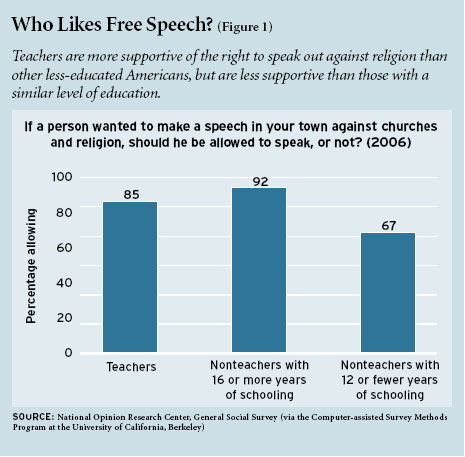
Social Issues
Education has a powerful effect on Americans’ valuation of the right to free speech. In 2006, for example, 67 percent of Americans with a high school education or less would allow an atheist to speak, but 91 percent of those with 16 or more years of schooling would. Highly educated Americans are about 24 percentage points more likely than their less educated counterparts to support the free-speech rights of an atheist.
Teachers tend to be more educated than other Americans, averaging more than 16 years of formal schooling compared to about 13 years. Accordingly, their being more supportive of free speech is likely due to their higher education levels. But, somewhat surprisingly, when we compare teachers and others with similarly high levels of education,we find that teachers tend on average to be less supportive of free-speech rights (see Figure 1). On the issue of free speech, teachers are progressive relative to nonteachers, but conservative relative to nonteachers with high levels of schooling.
Over the last four decades, Americans in general have grown more tolerant of homosexuality. In the 1970s, 13 percent of nonteachers said there is nothing wrong with homosexuality. By 2006, 32 percent of them felt this way. During the 1970s, 18 percent of teachers also saw nothing wrong with it. By 2006, about a third saw nothing wrong with it; there was no significant difference between the two groups. If we control for education, however, we find that in each of the four decades, teachers are from 10 to 15 percentage points less likely than other Americans with 16 or more years of schooling to see nothing wrong with homosexuality (see Figure 2).
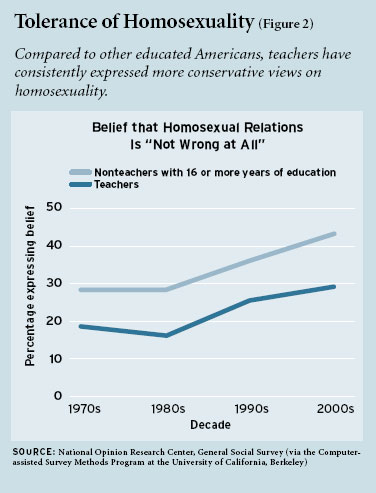
About 60 percent of teachers and an equal proportion of other Americans say they are opposed to legalized abortion.Analysis of the survey data show class, gender, and education are all positively correlated with being in favor of legalized abortion. Americans who place themselves in the middle or upper classes, women, and the more highly educated all tend to favor abortion being legal. But teachers are about 14 percentage points more likely to oppose abortion for any reason than highly educated nonteachers–that is,they are more conservative on the issue.
American teachers tend to be more conservative than other Americans on issues of pornography as well. In 2006, 50 percent of teachers said they would make pornography illegal, while only 38 percent of nonteachers shared this view. The difference between teachers and highly educated nonteachersis even greater: only 29 percent of nonteachers would make pornography illegal.
Religion
God and religion play an important role in the lives of more than half of all Americans. In a study conducted by the European Values Study Group and World Values Survey Association, 58 percent of the U.S. population said that God was very important in their lives, a greater percentage by far than in the populations of other developed countries such as Great Britain (14 percent),France (8), Italy (33), Japan (7), Spain (17), or Germany (9).
Religion and education have always had a close relationship in the United States. The country’s first institution of higher education,Harvard College, was established in 1636 to train ministers. Many of the country’s first teachers were ministers and parsons. Even when women came to dominate the teaching field, religious values were still a priority. We should not be surprised if elementary and secondary schoolteachers value religion highly, perhaps even more highly than Americans in general. But do they?
According to the NORC survey data from the current decade, about 37 percent of teachers say they attend church one or more times per week,while 26 percent of other Americans say they do so. Controlling for the education of nonteachers does not affect this difference. Of those nonteachers with 16or more years of schooling, 28 percent regularly attend church.
Looking at the data across the 1980s, 1990s, and 2000s, we find that teachers are about 9 to 11 percentage points more likely than other Americans as a whole to pray one or more times per day. During the 1980s and 1990s, Americans were asked how close they felt to God. Teachers were about 8 percentage points more likely than other Americans to report feeling”extremely close” to God.
Why do teachers, by these measures, seem more religious than other Americans? Perhaps the differences are due to gender. Most teachers are women, and women are more likely than men to be frequent churchgoers and more likely to pray one or more times a day. In fact, we find teachers of both genders to be more religious than nonteachers. Female teachers are about 8percentage points more likely to attend church frequently than female nonteachers, and male teachers are 16 percentage points more likely to attend church frequently than male nonteachers(see Figure 3). Teachers are apparently more religious than other Americans, regardless of gender or education.
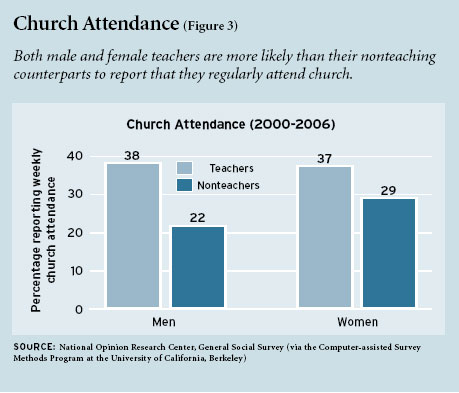
Does teachers’ religious orientation translate into support for school prayer? Do they approve or disapprove of the U.S. Supreme Court’s ruling that prohibits prayer in public schools? Given the priority that teachers tend to give to religion, we might reasonably expect to find them more disapproving of the ruling than other Americans.At the same time, however, teachers have a relatively high level of education, and the more education Americans have, the more they tend to approve of the Supreme Court’s ban on school prayer. In 2006 about 57 percent of nonteachers were against the Supreme Court’s ban on school prayer,while only 36 percent of teachers opposed it. But, again, the difference seems to be largely due to education. Looking at only those with 16 or more years of schooling, we see no significant difference between teachers and nonteachers, with slightly more than one-third of each group opposing it.
Economic Inequality
While there is disagreement about how much economic inequality exists in the United States, about 45 percent of teachers and nonteachers believe the government ought to act to reduce income differences. This sentiment has remained fairly stable over the last four decades, decreasing only slightly from about 48 percent in the 1970s to about 46 percent in the current decade, and teachers have not differed significantly from this mainstream view.
Americans have also been asked whether the government should help the poor. Since the 1970s, the percentage of all Americans who believe the government should help the poor has dropped from about 40 percent to about 28 percent, a 30percent decline. Over the same period, the percentage of Americans who felt that the poor should help themselves climbed only from 24 to 26 percent.
Where do teachers stand on whether the government should help the poor? They have followed much the same trajectory as all Americans, but declining more sharply, going from about 48percent in the 1970s, to 24 percent in the current decade, a 50 percent drop.
The chord of individualism struck by Ronald Reagan and carried on by his successors has clearly had an impact. But it has not resulted in a wholesale movement away from government lending a hand to the poor. The trend has been toward a mixed approach, in which the government is expected to help the poor and the poor are also expected to help themselves.
Human Nature
Every good teacher looks for the human potential in her students; she works with the hope that it can ultimately be realized, that it will be at its best and not at its worst, and that she will have had some hand, however small, in the business of human betterment. Because the work of teachers addresses the development and growth of human beings, the teacher must necessarily be concerned with human character. Whether she wishes to admit it or not, she works with a set of beliefs about human nature. Sometimes these take the form of conscious beliefs about the nature of human beings.More often they are assumptions seldom articulated but ever present in her daily work. In either case, her beliefs and values shape how she goes about her work and interacts with children. It is useful, therefore, to examine briefly some indicators of what teachers think about the nature of human beings and the world they live in.
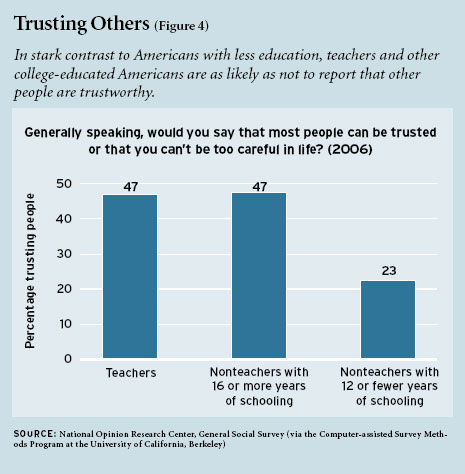
The NORC survey contains a set of questions about how the respondent views the world and the people who inhabit it: Is the world basically evil and full of sin or is it essentially good, reflecting God’s goodness? If we look at the data from all of the years the question has been asked, 1985-2002, we find that about 69 percent of teachers believe the world is more good than evil, compared to about 53 percent of other Americans. Teachers are about 6 percentage points more likely to see it as good than other Americans with 16 or more years of education.
Trust is one of the building blocks of social capital; it is our willingness and capacity to cooperate to solve common problems.Without it, little productive economic and social activity can occur. This is as true in schools as it is in other social institutions.
The more education people have, the more trusting they tend to be. In 2006, highly educated Americans were about 24 percentage points more likely to be trusting than the least educated: only 23 percent of Americans with a high school education or less said that people could be trusted, while 47percent of those with 16 or more years of schooling felt this way. If we control for the education of nonteachers, we find that teachers tend to be no more or less trusting than educated nonteachers (see Figure 4).
Schooling for Democracy
As a group, American teachers tend to be more supportive of free-speech rights than other Americans, but when compared to other Americans with 16 or more years of schooling teachers are less supportive of this important democratic value. We see a conservative tendency when we examine teachers’ family values as well. Though better educated Americans tend to be more liberal, teachers appear to be somewhat of an exception. On homosexuality and abortion, teachers tend to be more liberal than less educated Americans but more conservative than those with high levels of education. Teachers also attend church and pray more than nonteachers, additional indications of their conservative leanings. Finally, over the past four decades, support among teachers for the liberal view that the government should help the poor has declined more sharply than it has for other Americans.
Teachers’ conservative propensity does not appear to be uniform across their values. They are more liberal than nonteachers,for example, when it comes to school prayer, a stance seemingly inconsistent with their strong religious turn. Moreover, they seem to be more likely to see the world as good, and they tend to be more trusting than other Americans.
When it comes to some important values, then, teachers seem to present something of a paradox: they are both progressive and conservative. That teachers have a conservative inclination is not a new observation but goes back at least to John Dewey’s work and to Dan Lortie’s classic Schoolteacher. As members of a society committed to the democratic ideal as a chief organizing principle, should we be concerned by teachers’ conservative tendencies?
In a democratic society people are free to be as conservative or liberal as their intelligence and conscience lead,but institutions built to nurture and sustain such a society are not, nor are their programs.Whether we wish to admit it or not, every education system tries to produce a certain kind of human being, attempts to develop in people dispositions to think, feel, and act in certain ways. The particular dispositions to be developed are themselves informed by the political-economic system in which the education system functions. A tyranny, a society in which only one person holds most of the power and rules with self-interest, requires that people think, feel, and act in ways supportive of an authoritarian regime. The primary aim of education in such a society is not to teach people to think for themselves or question things as they are. It is rather to dispose them to be compliant and obedient.In a democracy, not one but the many are supposed to rule in the interest of the whole. People need to be disposed to learn and appreciate the values of freedom and equality, the importance of trust, and the priority of reason and law. Such a society relies upon its schools and teachers to develop these and other democratic dispositions in its students. Accordingly, we should want and expect our teachers,more than others, to be disposed to think and feel in ways supportive of a democracy. So, for example, we would prefer to find our teachers falling more on the side of freedom and equality than of censorship, coercion,and inequality.
In more practical terms, this means that we should expect our teachers to be committed to the democratic ideal as an organizing principle for our society and for instruction in their classrooms. Preservice programs should help teachers develop the disposition to look persistently for ways to teach in accord with the democratic ideal, and to seek ways to minimize distractions from this important task. Finally, and perhaps most important in our time,commitment to the democratic ideal as an organizing principle does not mean commitment to any particular social or political ideology. It rather depends on a felt need, what in Spanish is called a “necessidad sentida,” to understand the American experiment at its best and to see it realized in the classroom.
-Robert O. Slater is professor of education at the University of Louisiana-Lafayette.


